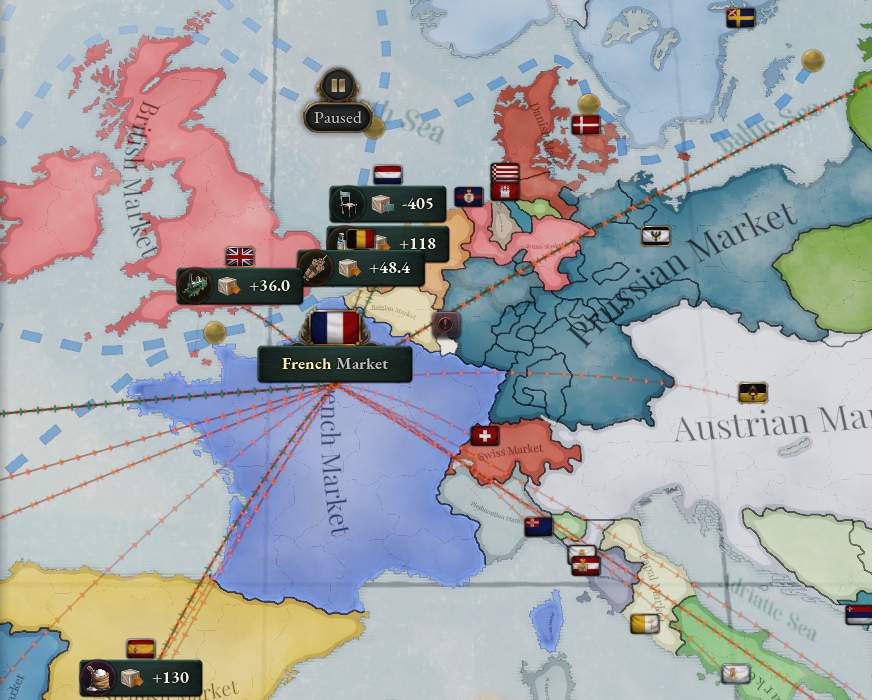
Guide to Market
Intro
In Victoria 3, a single unit of goods is produced and immediately sold at a price determined by how many consumers are willing to buy it at the moment of production. When this happens prices shift right away along with actual supply and demand, and trade between markets is modelled using buy and sell orders — thereby making the economic model more responsive to sudden economic shifts. Any stockpiling in the system is represented as cash (for example, through a building’s cash reserves or a country’s treasury) or as pop wealth, which forms the basis for standard of living and determines their level of consumption.
National Market

A bird’s eye view of the French market.
National markets are what drives the game’s dynamic economy by determining a rational price based on supply and demand for all trade goods in every state throughout the world. Expanding the national market to encompass more territory means more raw resources for the country’s furnaces and more customers for its manufacturing industries. As the player’s industrial base grows, so does its country’s demand for infrastructure to bring goods to market.
By default, every country is in control of its own market which is typically (but not always) centered on their capital state. Every state connected to this market capital — over land or by sea through ports — is also part of the market. These states all have a variable degree of market access representing how well-connected they are to every other state in the market.
All local consumption and production in the states contribute to the market’s buy orders and sell orders. These are akin to orders on a commodity market — for example, higher consumption of grain will cause traders to submit more grain buy orders while higher production of silk will result in more sell orders for silk.
Shared market
Diplomatic gameplay. It is possible for several countries to participate in a single market. Sometimes this is the result of a customs union pact led by the more powerful nation, but more often it’s because of a subject relationship with a puppet or semi-independent colonies. In certain cases, countries can even own a small plot of land inside someone else’s market, such as a treaty port. The route to expanding a country’s economic power is not only through increasing domestic production and consumption, but also through diplomatic and/or military means.
Market Price
All goods have a base price. This is the price it would fetch given ideal market conditions: all demand is fulfilled perfectly with available supply, with zero goods produced in excess of demand. For example, if buildings produce more than is being demanded each unit produced will be sold at a reduced price. This benefits consumers at the detriment of producers. Similarly, if demand is higher than supply, each unit produced will be sold at an increased price. This brings more income to the producing buildings on the expense of pops and buildings that rely on those goods to continue operate.
A market price is based on the balance between a market’s buy and sell orders with the base price as a baseline. The more buy orders than sell orders the higher the price will be and vice versa. Buy and sell orders submitted to the market are scaled by the amount of market access the states have. This means a state with underdeveloped infrastructure will trade less with the market and rely more on locally available goods.
States with full market access will use the market price for all its goods. Otherwise, only part of the market price can be used, with the remainder of the local price made up by the local consumption and production of the goods. All actual transactions are done in local prices, with market prices acting to moderate local imbalances proportional to market access.
Oversupply and Undersupply
If an oversupply becomes large enough, the selling price will be so low producers will be unable to keep wages and thereby production volume up unless they’re receiving government subsidies.
On the opposite end, goods being in shortage leads to terrible effects for those in the market who rely on it; for example, drastically decreased production efficiency of buildings that rely on it as an input. Shortages demand immediate action, whether that be fast-tracking the domestic production, importing it from other markets, or expanding the market to include prominent producers of the goods. If all else fails, removing the need for said good from the building (by changing to an older production method) may restore the building to marginal profitability.





Be the first to comment